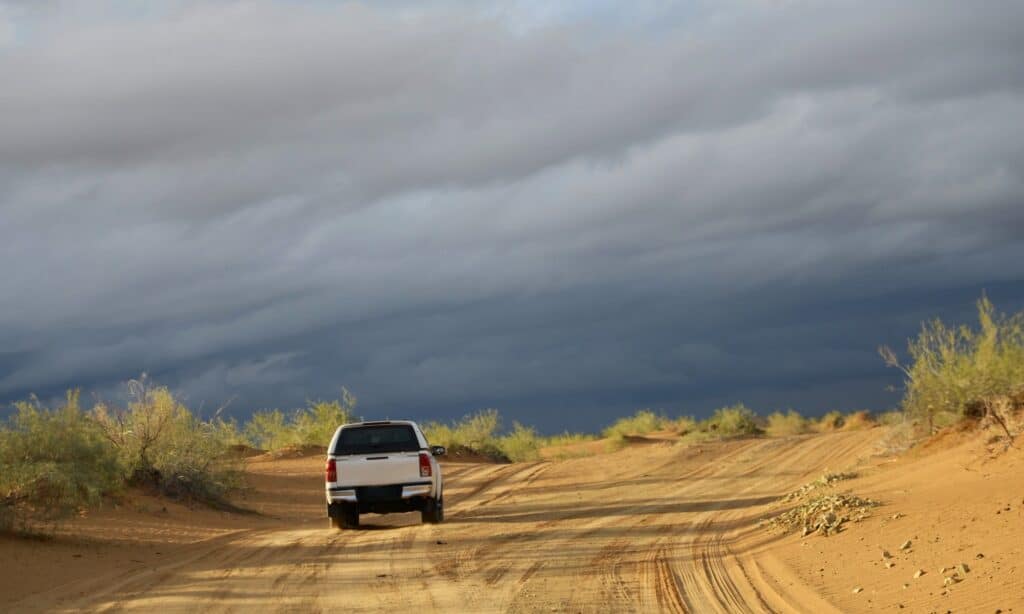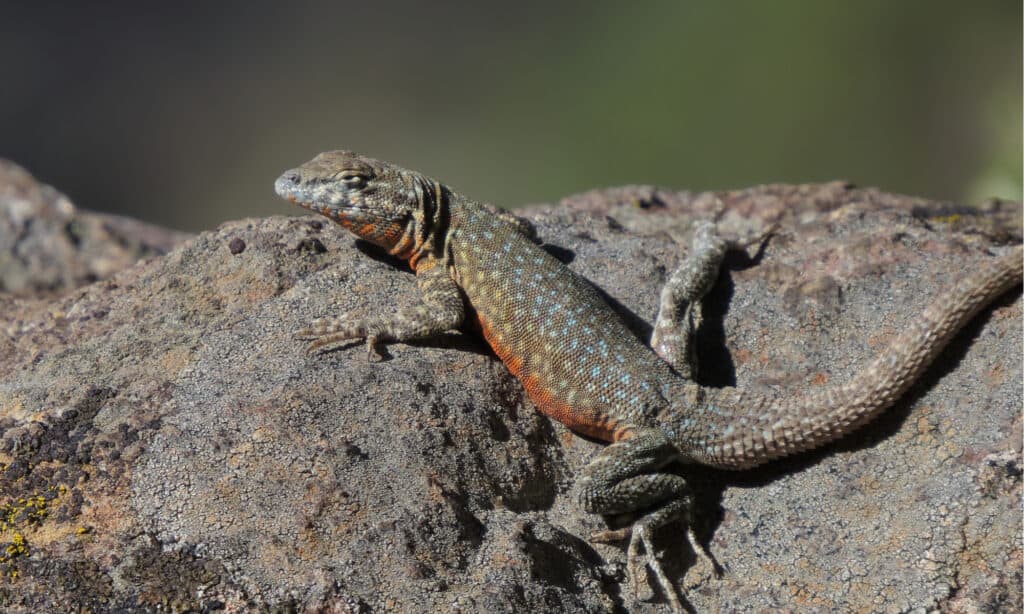The Karakum Desert is a sun-scorched desert that occupies roughly 3/4 of the territory of Turkmenistan, a country in Central Asia. This massive expense of dunes is one of the largest deserts in Asia and one of the world’s largest deserts. Although mainly characterized by loose desert sands and lifeless rocky areas, the Karakum desert is also interspersed by lakes and desert oases with scanty plant and animal life. The main highlight of this desert to tourists is the famous Darvaza Gas Crater located in the heart of the desert.
Karakum Desert – Location And Name
The name “Karakum Desert” is sometimes spelled as “Kara-Kum” or “Garagum” (Gara Gum). This is a Turkmen word that translates as “black sand,” a reference to the dark-colored soil underneath the sand of the desert. The soil is dark in color because it is naturally rich in shale – a type of sedimentary rock formed from organic matter deposits.
The Karakum Desert is located in Central Asia. Up to 70% of the desert is found within the territory of Turkmenistan, a landlocked country in Central Asia bordered by Kazakhstan, Uzbekistan, Afghanistan, Iran, and the Caspian Sea. The Karakum Desert combines with the Kyzylkum Desert to form the Southern Central Asia Desert.
Karakum runs between the Sarykamysh Basin and the foothills of the Kopet-Dag Mountains in the north and south, respectively. On the northeast and east, it is bordered by the Amu Darya Valley, formed by an ancient Oxus River. The southeastern border of the desert is next to the Badkhyz steppe area and the Garabil uplands. The ancient valley of the Uzboy River forms this desert’s western and northwestern limits.
Karakum Desert – Size

With a size of 135,000 square miles, the Karakum Desert is one of the largest in Asia.
©iStock.com/Rini Kools
The Karakum Desert is one of the largest deserts in Central Asia and ranks 10th among the largest deserts in the world when you exclude the polar deserts. It covers an area of land that’s approximately 135,000 square miles (350,000 square km). From east to west, the desert is about 500 miles (800 km) long. It is about 300 miles (500 km) from north to south.
Generally, the desert landscape is divided into three parts. This includes an elevated area in the north known as the Trans-Unguz Karakum, a low-lying central area, and the southeastern Karakum, which is also low-lying.
Karakum Desert – Climate
The Karakum Desert has a predominantly continental climate. This is mainly characterized by long and extremely dry summers. However, winter in Central Asia is warm for a continental desert.
The Caspian Sea significantly influences the climate and average temperature in the Karakum Desert. Hence, temperature and rainfall vary from one part of the desert to another based on proximity to the Caspian Sea. The average summer temperature in the Northern area (which is closest to the sea) is between 26 to 28°C. However, as you go toward the center of the desert, the temperature varies from 30 to 34°C
During winter, the temperature in this desert drops to an average of -4°C in the northern area, while the average temperature in the south is +4 °C. However, temperatures can get as low as -20 °C and as high as 10 °C on some days.
This desert is the hottest sandy region in Central Asia. It receives about 2.7-5.9 inches (7-15 cm) of rainfall yearly. Rain only falls in this desert during winter and early spring (between December and April). Snowfall occasionally occurs as well.
Karakum Desert – Geography and Features

The Karakum Desert is home to the ‘Gates of Hell’ gas crater.
©Matyas Rehak/Shutterstock.com
The surface of the Karakum Desert is made up of loose sands on a shale layer. The dark-colored shale is the reason for the desert’s name (dark sands). The surface features of the desert depend on which part of it you’re in. In the northern area (Trans-Unguz Karakum), wind action is responsible for the physical topography of the land.
The plains of the central area of Karakum are made up of wind-accumulated sand ridges that may measure between 250 to 300 feet (75 to 90 meters) on average. About 10 percent of this area consists of crescent-shaped dunes, otherwise known as barchans. These are typically about 30 feet (9 meters) in height on average.
The region receives scanty precipitation, and the water mostly collects in basins formed by thick clay deposits. The clay deposits form interdune depressions and may be as thick as 30 feet (9 meters) in some places. The water from these catchment basins makes it possible to grow fruits in this desert. The basin also forms saline areas known as solonchaks as the subsoil evaporates. The chains of salt marshes are more common in the central and southeastern Karakum.
Perhaps the most popular physical feature of the Karakum Desert is the Darvaza Gas Crater. More famously referred to as a “Door to Hell,” or the “Gates of Hell,” the Darvaza Gas Crater is a natural gas crater that oil explorers lit on fire in 1971 and has been burning ever since. It is a major attraction, visited by hundreds of tourists every year.
The Karakum Canal, which is the second-largest irrigation canal in the world, crosses the desert. The canal, which was constructed in 1958, brings water from the Amu Darya in the north to the desert’s southern regions of the desert.
Karakum Desert – Plant and Animal Life

Lizards have a very good population in the Karakum desert.
©John Rakestraw/Shutterstock.com
The Karakum Desert has scanty but varied vegetation made up of grass, small shrubs, and a few trees. The little precipitation the region receives during winter allows the growth of ephemeral plants at the start of the spring. These serve as the main source of food for the animal life in the desert.
Grasses, wormwood shrubs, and a few trees grow on the barchan dunes of the desert. The most common tree species is the Ammodendron conollyi (sand acacia), while desert bushes like the saltwort, Astragalus, and Calligonum are also common. White saxaul (Haloxylon persicum) grows in the desert, especially in places with deep underground water, while the black variety Haloxylon aphyllum is more common in areas with water closer to the surface.
The Karakum Desert has a limited number of animals. However, it has a variety of them, including insects like ants, termites, and beetles. Like most deserts, it also has a good population of reptiles (especially lizards and snakes). Birds are also quite common. The most popular ones include skylarks, saxaul sparrows, wagtails, and pander’s ground jays.
A few mammals can be found in this desert. This includes rodents like gophers and jerboas. Other mammals you might see in the desert plains include the tolai hare, barchan cat, corsac fox, and goitered gazelle.
Up Next
The 15 Largest Deserts in the World
The 10 Most Amazing Desert Animals
This is The Largest Desert In Africa
The photo featured at the top of this post is © iStock.com/Rini Kools
Sources
- Central Asia Guide (1970) central-asia.guide/turkmenistan/destinations-tr/karakum-desert/
- Wikipedia (1970) en.wikipedia.org/wiki/Karakum_Desert
Thank you for reading! Have some feedback for us? Contact the AZ Animals editorial team.






